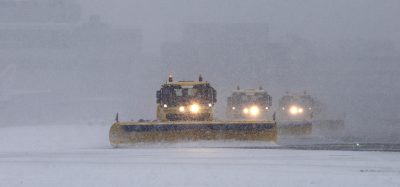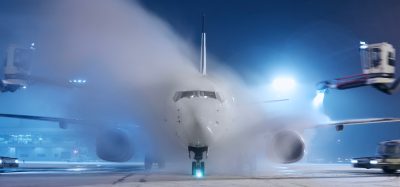Let it snow
- Like
- Digg
- Del
- Tumblr
- VKontakte
- Buffer
- Love This
- Odnoklassniki
- Meneame
- Blogger
- Amazon
- Yahoo Mail
- Gmail
- AOL
- Newsvine
- HackerNews
- Evernote
- MySpace
- Mail.ru
- Viadeo
- Line
- Comments
- Yummly
- SMS
- Viber
- Telegram
- Subscribe
- Skype
- Facebook Messenger
- Kakao
- LiveJournal
- Yammer
- Edgar
- Fintel
- Mix
- Instapaper
- Copy Link
Posted: 5 October 2011 | Hanspeter Moll, Head of Airfield Maintenance and Winter Operations, Zurich Airport | No comments yet
In over 60 years of operation, Zurich Airport has never had to be closed down because of snow – a fact the airport is immensely proud of. Last year Several European airports fought harsh winter weather conditions and some hubs – such as Frankfurt and London Heathrow – had to temporarily halt operations or close down completely.
As a consequence, aircrafts had to divert to Zurich Airport as their alternate airport, demanding high flexibility from all airport partners involved. While ground staff were facing stressful and hectic times, airplane spotters cheered! Numerous aircraft diversions brought unique photo opportunities and rare guests to Zurich, such as an additional Airbus A380 from Singapore Airlines that had to divert to Zurich from London Heathrow.
What distinguishes Zurich Airport from other European airports? Why is snow not a reason for the declaration of a state of emergency? The answer is a combination of several factors: An experienced crew, excellent equipment, a reliable alarm and first response system, regular training and tremendous commitment.
In over 60 years of operation, Zurich Airport has never had to be closed down because of snow – a fact the airport is immensely proud of. Last year Several European airports fought harsh winter weather conditions and some hubs – such as Frankfurt and London Heathrow – had to temporarily halt operations or close down completely.
As a consequence, aircrafts had to divert to Zurich Airport as their alternate airport, demanding high flexibility from all airport partners involved. While ground staff were facing stressful and hectic times, airplane spotters cheered! Numerous aircraft diversions brought unique photo opportunities and rare guests to Zurich, such as an additional Airbus A380 from Singapore Airlines that had to divert to Zurich from London Heathrow.
What distinguishes Zurich Airport from other European airports? Why is snow not a reason for the declaration of a state of emergency? The answer is a combination of several factors: An experienced crew, excellent equipment, a reliable alarm and first response system, regular training and tremendous commitment.
Years of experience
The swift removal of snow from runways and de-icing of tarmac surfaces as well as airside streets are amongst the top priorities of the airport’s winter operations. Aircraft de-icing is executed by two handling agents. The coordination, however, lies within the realm of Zurich Airport’s responsibilities, more specifically, with the department known as ‘Airport Steering’. This committee co-ordinates the interests of various airport partners who participate in relevant airport operation processes. The goal is to keep the airport running as smoothly and efficiently as possible – regardless of weather conditions. Flughafen Zürich AG, the airport operator, administers airport resources such as passenger busses, stands, gates and the baggage sorting system and oversees general airport operations. Within Airport Steering, other airport partners – like the hub carrier Swiss International Airlines or the major handling agent Swissport – are responsible for specific processes and services, for example check-in procedures, ticketing, baggage handling, aircraft cleaning, security controls, crew transportation, on-board catering and aircraft de-icing.
One of the main advantages of Airport Steering is the fact that all representatives of the various airport partners are working in the same room, thus guaranteeing quick information channels and a swift decision making process – especially during exceptional conditions such as heavy snow.
Organisation
As part of the airfield maintenance, winter operations are independently organised, but work closely with the Airport Steering and Airport Authority departments, two crucial entities at Zurich Airport. During the winter season, which lasts from mid-October until mid- April, around 320 employees are ready for duty around the clock. One hundred and twenty personnel work within airfield maintenance, another 200 are external employees working mostly as drivers for the special vehicle units.
The call to duty usually comes from the Airport Authority, whose managers meticulously observe the weather using radar pictures, meteorological reports and ground temperature measurements. For example, if snow is to be expected the following day, the Airport Authority dispatches winter operations for the next day. The units are divided into three categories: runways, tarmac and stands. Duty for winter operations personnel usually starts with a call at 3am. This may be even earlier depending on the particular weather conditions. Whenever it comes, the team is expected to react promptly, as all units need to be ready for operation within one hour.
Experienced team
The airport staff are used to the exceptional working conditions that distinguish winter operations. “You have to be highly focused and watch out for everything,” reports one driver. “During heavy snowfall or in the dark of the night, it’s sometimes challenging to maintain your sense of orientation. However, when I’m out on the runway I am wide awake and alert. It’s a real adrenaline rush.”
The longest continuous duty ever was recorded during the winter of 2010/2011, when on a particularly cold day, winter operations units were on duty for 80 hours non-stop. In December of 2010, the groups were on duty every day of that month.
Equipment
Another crucial aspect for the success of Zurich Airport is the equipment. In the past four years, the airport operator has invested 18 million Swiss Francs for 20 new vehicles for winter operations. These specialised vehicles – a key trait being their enhanced maneuverability and speed – have been developed specifically for Zurich Airport and have replaced part of the existing fleet of vehicles. With this modernisation, the airport possesses pioneering equipment. Now, a total of 120 vehicles are ready for duty at any time.
One unit consists of seven Jet Broom trucks by Boschung, one snow-blower by Overaasen as well as two snow-ploughs and a dispatcher car. In addition, a trio of smaller trucks are responsible for the cleaning of taxiways and another unit of eight vehicles takes care of the de-icing of tarmac areas and streets. The vehicles drive in a row, where a fully-fledged cleaning of runway 16, the longest runway at Zurich Airport, takes 25 minutes.
With their 8.5 meter wide ploughs, the trucks execute a first ‘rough sweep’ of runways and taxiways. The rotating brushes attached between the front and rear axle swipe away the slush and clean the surface of snow and ice. After that, the remaining surface humidity is blown off the surface, making it not only clean but dry. If necessary, surfaces are sprayed with an environment-friendly de-icing fluid, thus ensuring that snow won’t immediately stick to the surface again. Salt is not used on the tarmac, as it would corrode aircraft wings and engines. This is why Zurich Airport resorts to formic acids on airside surfaces. Salt is only used on streets and landside premises.
Another reason why Zurich Airport has never had to close down during the winter is due to its storage management, more specifically its anticipatory storing of de-icing fluids and well established delivery conditions. Roughly 500,000 litres of de-icing fluids for surface cleaning are stored at Zurich Airport. Up to today, this storage has been sufficient for the needs of winter operations, thanks to reasonable use during peak times. Subsequent delivery for de-icing fluids as well as salt is guaranteed during the entire winter season.
De-icing of aircrafts
Whilst the airport steering department coordinates all aircraft de-icing activities, the actual de-icing is executed by two handling agents, with Swissport holding the major share of the de-icing work and AAS being a smaller second player. A mix of glycols and hot water is used for the de-icing process. The suppliers for these de-icing fluids are located in England and the Netherlands. With the supplies on location, Zurich can handle between 500 and 600 aircraft de-icings. A second storage unit is located nearby and available for additional deliveries every other day, if necessary. While de-icing supplies have run low in the past on a few occasions, Zurich Airport has never actually run out of fluids, neither for tarmac and street de-icing nor for aircraft purposes.
Environment
De-icing substances for aircraft are based on glycol and are in a low to medium concentration and widely biologically degradable. Zurich Airport already collects and treats 75 per cent of the carbon contained in de-icing-sewage occurring on apron, runways and taxiways. By the year 2015, this share will be increased to 95 per cent. The kind of treatment of de-icing sewage depends on its concentration of carbon. This small fraction of carbon is collected separately and disposed in a specialised external sewage plant. The medium contaminated fraction is irrigated through a spray system on suitable grass land at the airport. The decomposition of these substances then occur naturally by ways of micro-organisms within the soil. Thus 99.7 per cent of the carbon is decomposed. Low contaminated de-icing sewage is led through retention filter ponds, which lets the water drain slowly. When passing through the soil, the carbon is decomposed.
The ‘Böögg’
A delegation from the Airport Authority surprised the head of Airfield Maintenance in his office on a peak winter day and handed him a special gift, a “Böögg”. The Böögg is a ragdoll which represents winter and is burnt every year on a pyre in Zurich. Zurich locals are familiar with this custom to expel winter and invite an early spring. A man-sized ragdoll filled with firecrackers is burnt every year in downtown Zurich. The ragdoll handed to the head of Airfield Maintenance was no bigger than the size of a man’s hand. The gift also included a miniature pyre and a set of matches.
“We wanted to bestow a little gift that expresses both our gratitude and our sense of humour,” explained the head Airport Manager. “The underlying message being: the sooner winter is over and spring arrives, the better for any airport.”
Regardless of how the ragdolls burn and what else is done to expel the snow, one thing is certain: Zurich Airport will be ready for the next winter.
About the Author
Hanspeter Moll has been in the airport business for over 20 years. The trained engineer worked as a project manager in masterplanning before switching to environmental projects. With the privatisation of Zurich Airport in 2001, Hanspeter Moll became head of Airfield Maintenance. He holds an MBA degree and had his pilot license for 12 years before giving up flying to concentrate on other projects.

















